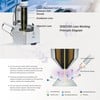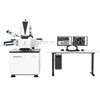Help with Electron Microscopes specifications:
Configuration
Back to Top
|
|
| ||
| Application: | |||
| Your choices are... | |||
| Biological / Life Science | Microscopes used for biological or life sciences inspections. These types of microscopes might include those that transmit light or environmental scanning electron microscopes (SEM). | ||
| Gemological | Microscope used for gemological inspection. These microscopes often use polarized light with lower magnifying powers to allow for brighter, sharper images combined with a wide field of view. | ||
| Medical / Forensic | Microscopes used for medical or forensic inspection purposes. These microscopes are often hands-free, binocular microscopes with lower magnifying powers to allow for brighter, sharper images combined with a wide field of view. | ||
| Metallurgical | Microscope used for metallurgical inspection. Often metallurgical microscopes are inverted for viewing the bottom of a sample with lower magnifying powers to allow for brighter, sharper images combined with a wide field of view. | ||
| Measuring / Inspection | Microscopes used by toolmakers for measuring properties of tools. These microscopes are often used for dimensional measurement with lower magnifying powers to allow for brighter, sharper images combined with a wide field of view. | ||
| Semiconductor Inspection | Microscopes used to study the layers in a semiconductor wafer or fabricated IC component. This inspection calls for greater precision and throughput. | ||
| Other | Other unlisted, specialized, or proprietary application. | ||
| Search Logic: | All products with ANY of the selected attributes will be returned as matches. Leaving all boxes unchecked will not limit the search criteria for this question; products with all attribute options will be returned as matches. | ||
| Microscope Type: | |||
| Your choices are... | |||
| Scanning Electron Microscope (SEM) | Scanning electron microscopes (SEMs) form images by using a detector synchronized with a focused electron beam to scan the object. The intensity of the image-forming beam is proportional to the back scattered or secondary emission of the specimen where the probe strikes it. The magnification is controlled by the length or area scanned. | ||
| Transmission Electron Microscope (TEM) | Transmission electron microscopes (TEM) pass image-forming rays through the specimen being observed. Contrast or diffracted beam images are used to analyze the sample. | ||
| Other | Other unlisted electron microscope. | ||
| Search Logic: | All products with ANY of the selected attributes will be returned as matches. Leaving all boxes unchecked will not limit the search criteria for this question; products with all attribute options will be returned as matches. | ||
Performance Specifications
Back to Top
|
|
| ||
| Accelerating Voltage: | The range of voltage used to produce electrons in scanning and transmission electron microscopes. | ||
| Search Logic: | User may specify either, both, or neither of the "At Least" and "No More Than" values. Products returned as matches will meet all specified criteria. | ||
| Total Magnification: | A ratio of the size of an image to its corresponding object. This is usually determined by linear measurement. This specification is meant to represent the entire magnification range of a microscope including both the eyepiece magnification and the objective magnification. | ||
| Search Logic: | User may specify either, both, or neither of the "At Least" and "No More Than" values. Products returned as matches will meet all specified criteria. | ||
| Resolution: | An optical device reveals the fineness of detail in an object. Objectively, resolution is specified as the minimum distance between two lines or points in the object that are perceived as separate by the human eye. Subjectively, the images of the two resolved points must fall on two receptors (rods or cones), which are separated by at least one other receptor on the retina of the eye. | ||
| Search Logic: | All matching products will have a value less than or equal to the specified value. | ||
Features and Options
Back to Top
|
|
| ||
| Digital Display? | A microscope that uses digital technology to display the magnified image. | ||
| Search Logic: | "Required" and "Must Not Have" criteria limit returned matches as specified. Products with optional attributes will be returned for either choice. | ||
| Computer Interface? | The microscope can be controlled or monitored remotely with a computer via interface. | ||
| Search Logic: | "Required" and "Must Not Have" criteria limit returned matches as specified. Products with optional attributes will be returned for either choice. | ||
| Image Analysis Processing Software? | The microscope has application software included for control or for analyzing images. | ||
| Search Logic: | "Required" and "Must Not Have" criteria limit returned matches as specified. Products with optional attributes will be returned for either choice. | ||
| Environmental / Low Vacuum / Variable Pressure? | The microscope is equipped with an environmental chamber, which allows it to maintain a pressure differential between the high vacuum levels required in the gun and column area and the relatively low pressures used in the chamber. This facility means that the microscope can be used to examine uncoated specimens such as type material, pinned insects, mineralogical specimens and fossils. Variable pressure electron microscopes allow the pressure in the sample chamber to be maintained at a much higher level than in conventional SEMs. The presence of molecules of air (or inert gas) in the chamber has two major effects. First, it significantly reduces outgassing from samples that are hydrated or oily. This allows these types of samples to be examined without the need for complex sample preparation, such as freeze-drying or critical point drying, etc. The second important benefit is that the air molecules also help dissipate the buildup of charge on the surface of nonconducting specimens, which means that they no longer need to be coated with a conducting layer before examination. | ||
| Search Logic: | "Required" and "Must Not Have" criteria limit returned matches as specified. Products with optional attributes will be returned for either choice. | ||


